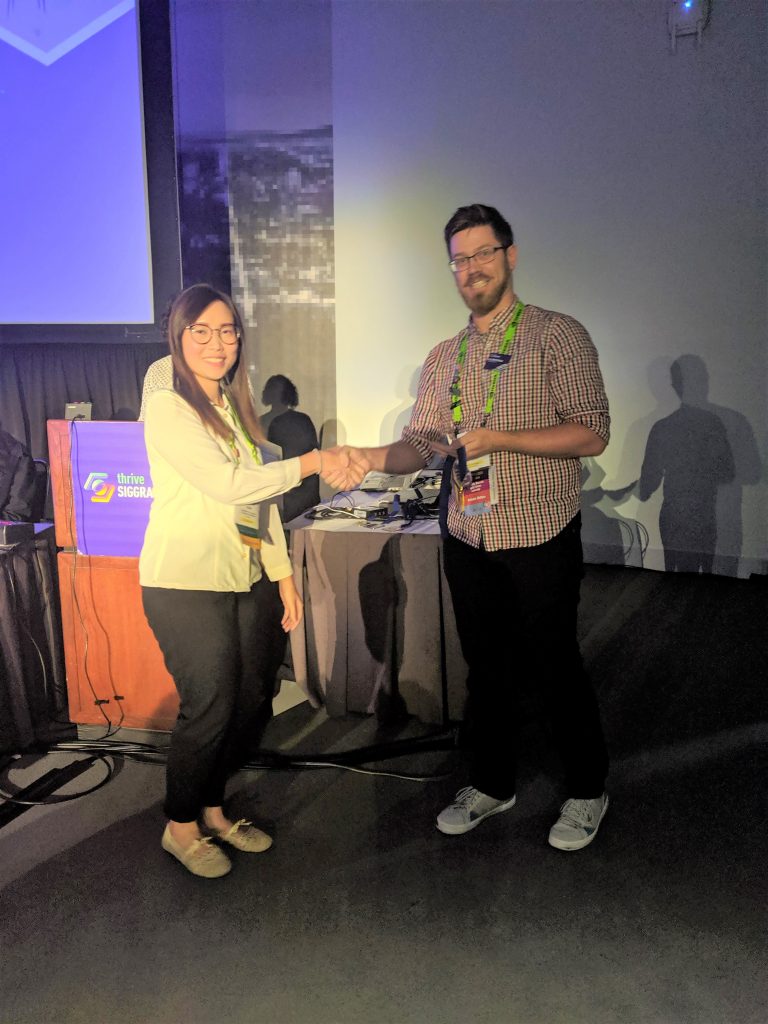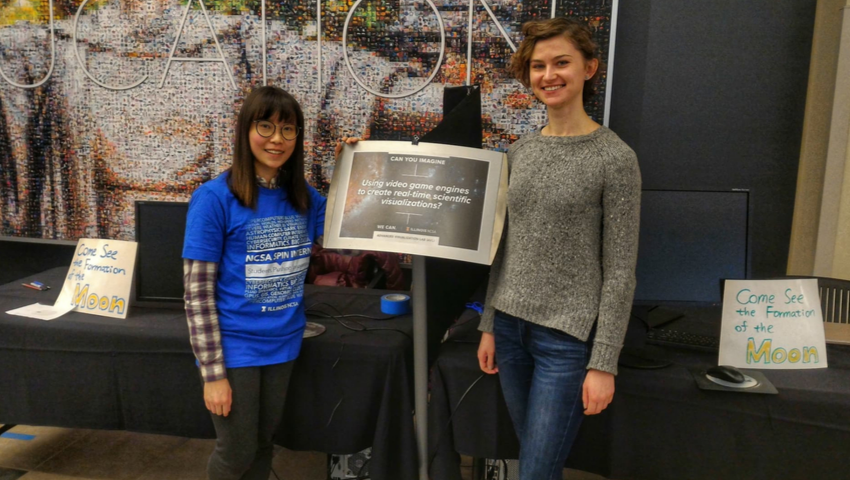Image credit: Jasmine Shih
Each year during the SIGGRAPH conference, the ACM Student Research Competition (SRC) — sponsored by Microsoft — offers a unique opportunity for undergraduate and graduate students to present original research before a panel of judges and participatns. This year, Jasmine Shih (NCSA Advanced Visualization Lab, University of Illinois at Urbana-Champaign) received the first-place prize in the undergraduate category for her poster, “Interactive Cinematic Scientific Visualization in Unity 3D.” We caught up with Jasmine to hear about how she developed the project, her first SIGGRAPH experience, and how her research has inspired future career plans.
SIGGRAPH: What was your reaction to winning the undergraduate category of the ACM Student Research Competition during SIGGRAPH 2019?
Jasmine Shih (JS): I was beyond thrilled and extremely grateful that my research project won first place in the undergraduate category. It was my first time conducting research, and I could not have done it without the support and guidance from my mentors at the Advanced Visualization Lab. It was also quite a large and interdisciplinary project as it involved coding, design, and a user study. To be recognized for a project that I devoted a lot of time to and personally cared about meant a great deal to me.
SIGGRAPH: Tell us about your winning research. What inspired it? How do you anticipate it might be used? What problems could it solve?
JS: We believe that scientific visualizations that are both cinematic and interactive have high educational value, so we began this project with the hope of finding feasibility and value in developing this kind of visualization in game engines, a powerful and easily accessible tool for creating interactive experiences. Through running experiments in the Unity game engine, with large sets of particle data, I benchmarked the performance of Unity and identified bottlenecks. These results helped me find ways to optimize the frame rate of the moon formation visualization that I developed in the next stage, and they could help researchers gauge the possibility of visualizing their data sets in Unity. In our survey study with children, the participants who viewed the interactive version of the visualization had higher enjoyment of the experience than those who viewed the non-interactive version. Because higher enjoyment is linked to higher motivation and other factors in learning, we believe that this result showed there is educational value in developing scientific visualizations in game engines. We hope that the results of this research project will encourage more in-depth research studies on the development of scientific visualizations in game engines and the effects of these visualizations on viewers.

Representative image for “Interactive Cinematic Scientific Visualization in Unity 3D” © 2019 NCSA Advanced
Visualization Lab, University of Illinois at Urbana-Champaign
SIGGRAPH: Share with us how you developed your poster. What steps were involved in the research process? What challenges did you face? Overcome?
JS: This research project consisted of three stages — performance testing and experiments, development of a moon formation visualization, and a survey study on the effects of the interactive visualization. I like to think that I played the roles of scientist, developer, and HCI researcher across each of the three stages, respectively, and faced different kinds of challenges throughout each of them.
In the performance testing stage, the biggest challenge was figuring out what to test. Writing code and working with a game engine was not new to me, but doing research on a game engine was completely different. Thankfully, I learned some fundamentals of scientific visualizations from my mentors who helped me come up with methods to obtain results that would be useful to the next stage. The challenges I faced in the survey study stage were not technical, but they were very interesting. For example, designing survey questions that targeted what we wanted to measure was difficult, and our intended participants being children didn’t make it easier. Reading papers on techniques for designing strong surveys helped me come up with seven questions, and my mentors assisted me with making the questions straightforward.
SIGGRAPH: Now that you’ve presented this research at SIGGRAPH 2019, what’s next for your project?
JS: I worked on this project as a student intern at the Advanced Visualization Lab in my senior year. Although a lot of potential future works can be done for the project, we consider it finished because we reached the objectives that we initially set. Since I’ve graduated and now work full-time as a software engineer, I do not have plans to expand this project in the near future.
SIGGRAPH: Tell us about your first SIGGRAPH experience.
JS: This was not only my first SIGGRAPH conference but also my first conference of any kind. In addition to presenting the poster and being in the research competition, I was also working as a student volunteer at the conference. Fortunately, despite having a packed schedule, I had the chance to attend some of the coolest events, such as a preview of the Computer Animation Festival Electronic Theater, Technical Papers Fast Forward, and Real-Time Live! I got very excited when I saw a clip from “Birth of Planet Earth” that the Advanced Visualization Lab worked on during the beginning of the [Electronic Theater]. Attending the conference with almost the whole lab team made my first conference experience less intimidating, and getting to see amazing works from both the entertainment industry and academia made it very enjoyable.
SIGGRAPH: How will receiving this SIGGRAPH award help you in your future career?
JS: I was in the stage of exploring my career interests when I started working on this project. Although I had always been sure that my academic pursuits were not going to end with my graduation from college, I had doubts about staying on the traditional computer science path in graduate school because I often found myself drawn more to the human-facing side of technology. Working on this research project helped me explore and confirm my interests in computer graphics and HCI [, or human-computer interaction]. Although receiving this award might later help me stand out in a pool of graduate school applicants, it most importantly boosted my confidence about making a change to my future career plans.

Jasmine Shih accepting her first place award.
SIGGRAPH: What advice would you give to other students thinking of submitting to an ACM conference or competition?
JS: I would advise these students to be unafraid of asking for advice from professionals and to reserve plenty of time to prepare their submissions. Research is full of uncertainty and challenges, so at times you might feel stuck. As students, you have access to academic professionals who are passionate about what they do and have valuable advice to offer. Communicating your questions and concerns with your mentors or professionals at your school will help you to become “unstuck” more quickly. As the submission deadline approaches, reserve a few weeks of time for putting your submissions together because, although you might know your research like the back of your hand, describing it with a limited number of words in a paper and fitting everything perfectly in a poster will take much longer than you expect.
Are you interested in submitting your latest project to SIGGRAPH 2020 in Washington, D.C.? Mark your calendar with these submission dates and stay tuned for more information.
 Jasmine Shih was born in Taipei, Taiwan, where she spent her first 15 years of life. She moved to Urbana, Illinois, with her mother in 2011. Following her graduation from Urbana High School, she studied computer science at the University of Illinois at Urbana-Champaign (UIUC) and received her bachelor’s degree in May 2019. During college, Shih worked as a student intern at the Advanced Visualization Lab from her sophomore year to senior year, and also worked as a course assistant for the virtual reality class in her last year. Shih currently works as a web developer at Verizon Media (formerly Yahoo!) in the research park of UIUC.
Jasmine Shih was born in Taipei, Taiwan, where she spent her first 15 years of life. She moved to Urbana, Illinois, with her mother in 2011. Following her graduation from Urbana High School, she studied computer science at the University of Illinois at Urbana-Champaign (UIUC) and received her bachelor’s degree in May 2019. During college, Shih worked as a student intern at the Advanced Visualization Lab from her sophomore year to senior year, and also worked as a course assistant for the virtual reality class in her last year. Shih currently works as a web developer at Verizon Media (formerly Yahoo!) in the research park of UIUC.



